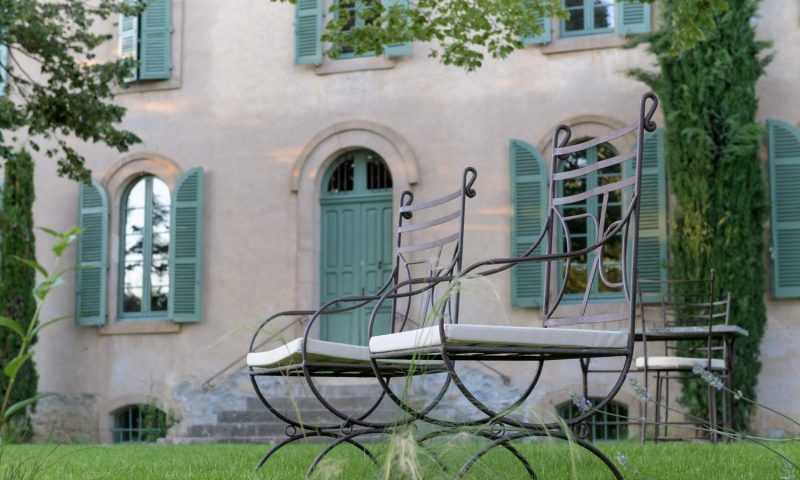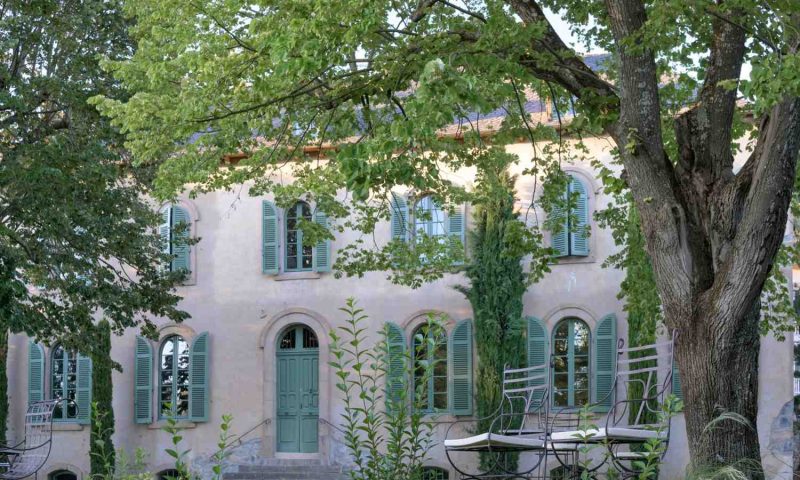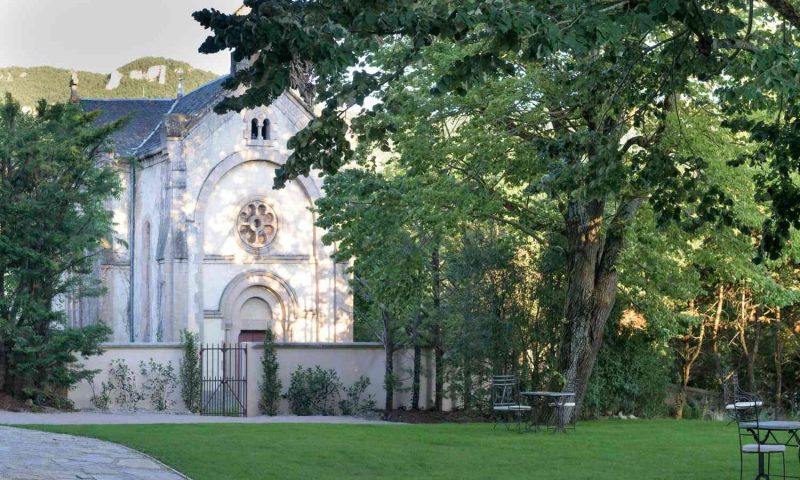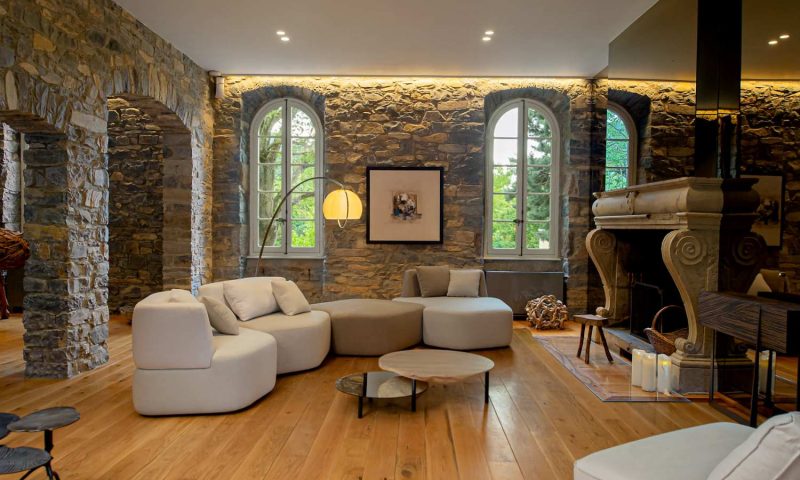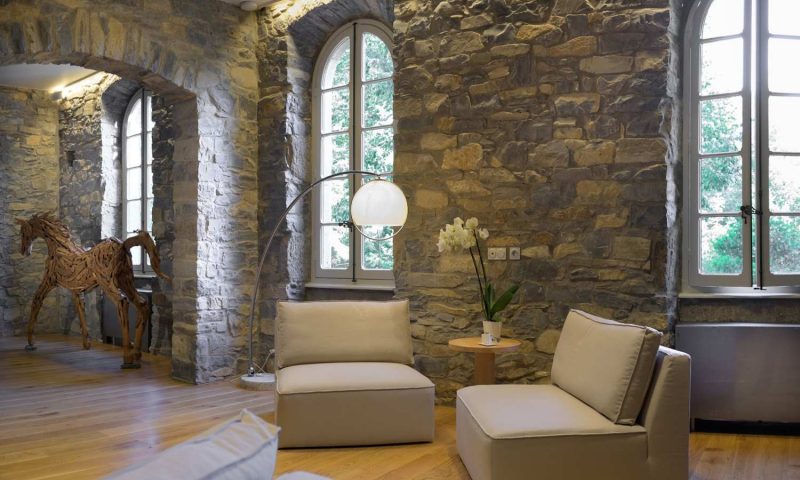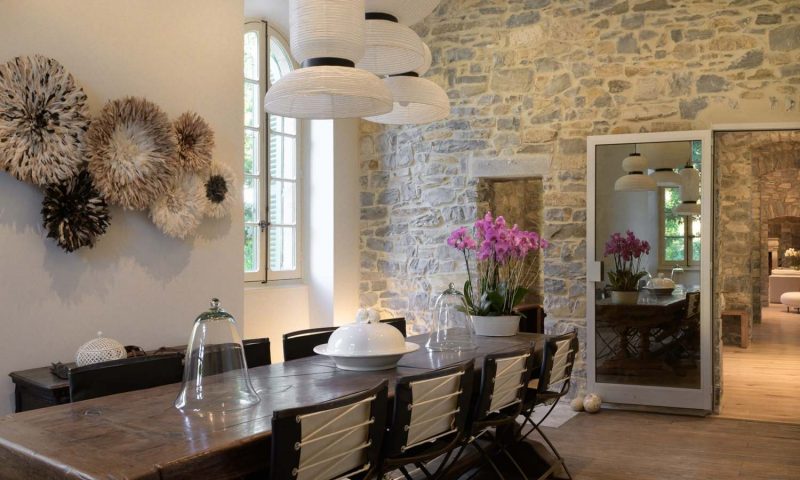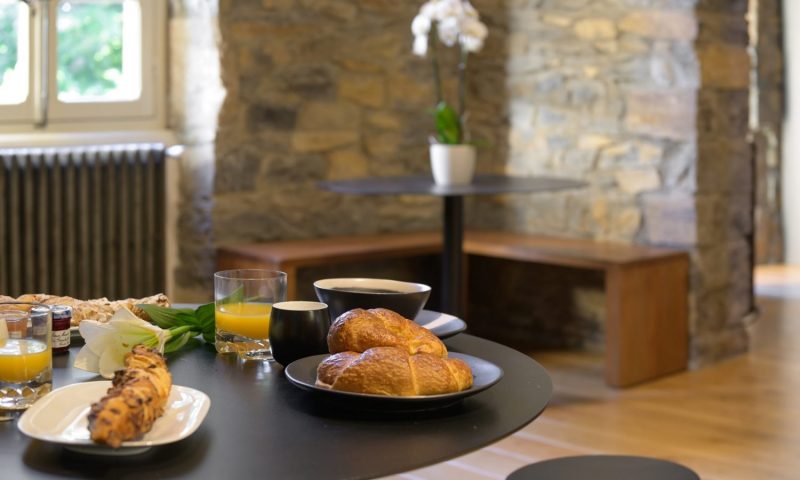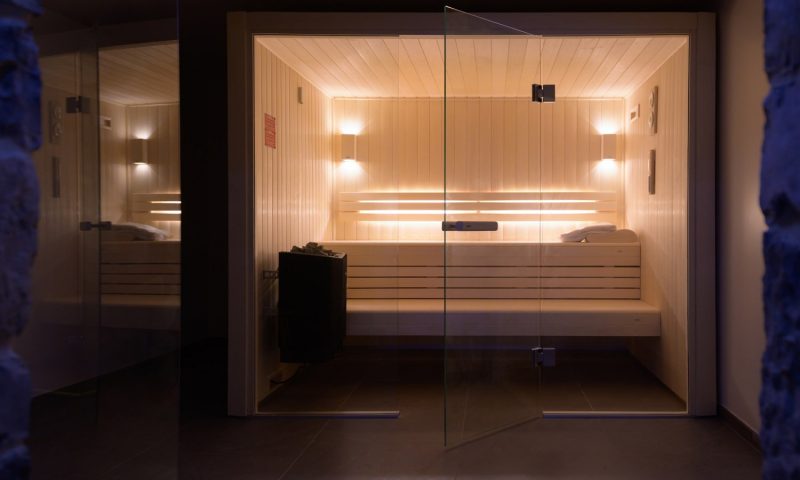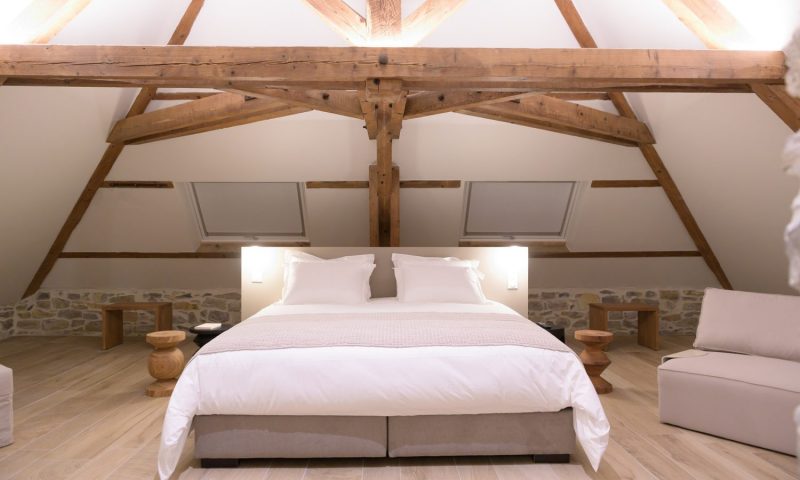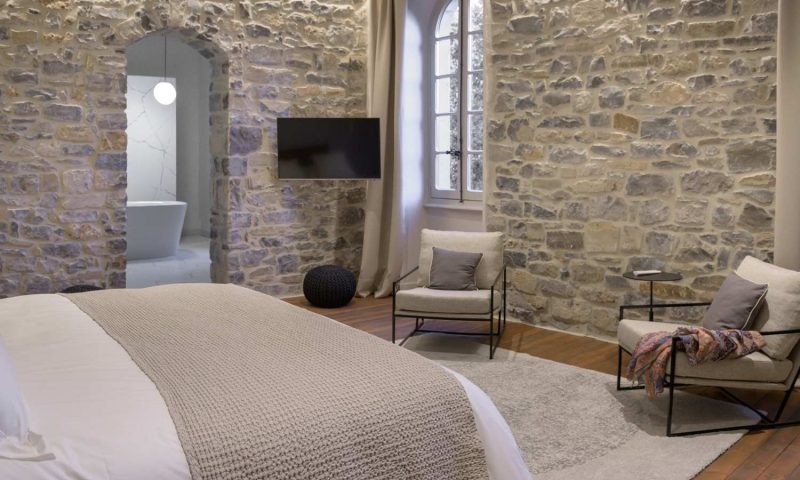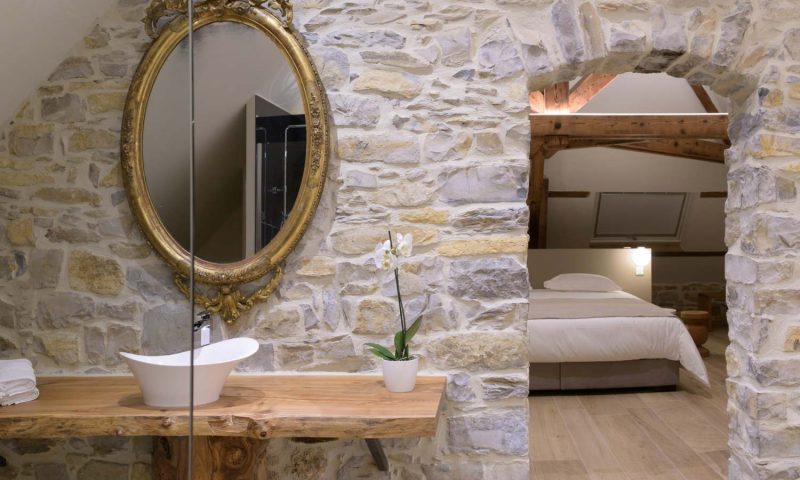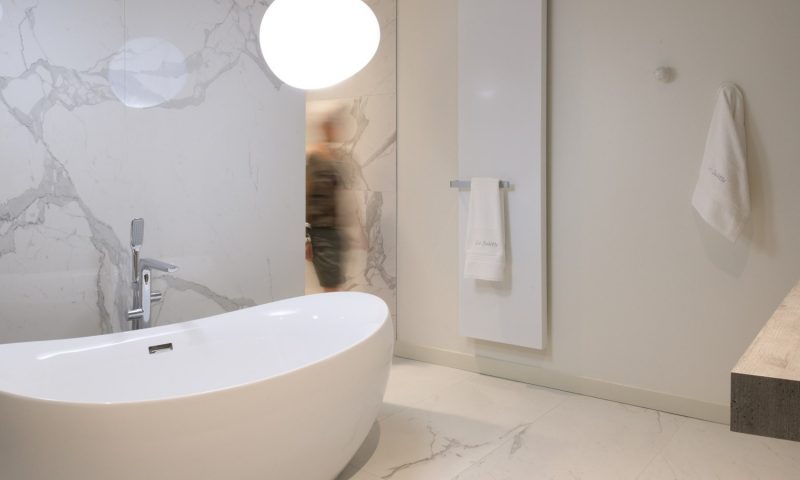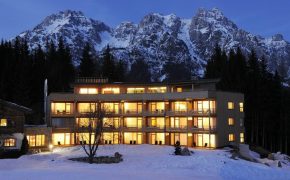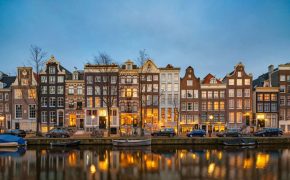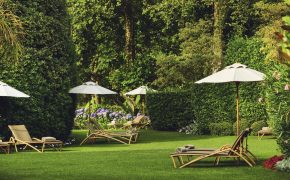The Couvent de la Salette offers four rooms and two suites, whose atmospheres are inspired by a collection of minerals and semi-precious stones belonging to Bruno Perris, mineralogy enthusiast and father of the current owner. Mystery, energy, voluptuousness…
Each room represents a unique universe, reflecting the colour and qualities of the stone whose name it bears. Tourmaline and Opal, Amethyst and Desert Rose…Facing the Grands Causses or overlooking the well-known viaduct, they are all designed and fully renovated for maximum comfort.
The average surface area of the rooms is 40m2 while the two suites offer 90m2 with freestanding bathtubs and king-size beds, all enhanced by the visual effects of wooden framework.
Celestine, also known as “angel stone”, is the ideal room for a family stay: this double bedroom can accommodate two adults and one child. The two connecting rooms offer a total surface area of 40m2. Stone and wood grace the bathroom, equipped with a walk-in shower and a large vanity. Enjoy a mineral ambiance and a touch of refinement thanks to its two gilded mirrors.
Malachite is ideal for couples. It offers a view of the Millau viaduct and the Dourbie, the Massif Central river that flows from the south of Mont Aigoual. This room has a total surface area of 39m2. The imitation-marble tiles tracing a fine network of branches create visual effects in the bathroom. A freestanding bathtub, a walk-in shower, an antique mirror, all lit up by ceiling lights designed by Foscarini.
Amethyst is ideal for couples. It offers a view of the chapel Notre-Dame de la Salette and the foothills of Larzac. Endowed with a small salon perfect for reading, it has a total surface area of 41m2. A combination of different materials sets off this brightly lit bathroom where large tiles with marble effects merge with concrete and stone. A freestanding bathtub, a walk-in shower, an antique mirror, all lit up by lights designed by Foscarini.
Tourmaline is ideal for couples. With a view of the Causse Noir and the Puncho d’Agast, it offers a total surface area of 37m2. The bathroom was inspired by the mineral tourmaline and its spectrum of blacks. The large freestanding bathtub and walk-in shower are matched with large slate tiles. Mineral, elegant, spacious.
The Opal. Looking out to the foothills of Larzac and the Puncho d’Agast, it offers a total surface area of 90m2: a vast space with an XXL bathroom and a bedroom embellished by the visual effects of wooden framework. Marble, stone and wood grace the XXL bathroom which marries antique and modern touches. Opening out to the bedroom, it comes with an elegant freestanding bathtub, an elm-wood vanity unit, a walk-in shower and a majestic gilded-wood mirror.
The Desert Rose. This suite, offering a view of the Millau viaduct and the Puncho d’Agast, has a total surface area of 90 m2: a vast space with an XXL bathroom and a bedroom embellished by the visual effects of wooden framework. Marble, stone and wood grace the XXL bathroom which marries antique and modern touches. Opening out to the bedroom, it comes with an elegant double bathtub, an elm-wood vanity unity, a walk-in shower and a majestic gilded-wood mirror.
The bar
As you lounge in a cosy atmosphere in front of the magnificent stone fireplace, why not savour an aged whisky – peaty or woody, take your pick – and discover our menu of regional wines? Feeling peckish? We can fix you a selection of Aveyron’s flavoursome artisanal products, cheeses or charcuteries.
The garden
In the shade of age-old lime trees, the garden of La Salette offers a lush setting, with background views of historic Millau, its viaduct and the pretty chapel Notre-Dame de la Salette.
Nearby, the Dourbie River flows its last few metres before meeting up with the Tarn River. Take advantage of the garden to read or indulge in a nap – unless the birds decide to interrupt this moment of drowsiness. The spa lies waiting for you.
The spa
Put time on pause… La Salette’s wellness space offers you a moment of relaxation in a refined atmosphere enhanced by mineral aesthetics. In this age-old stone setting you will find a jetstream spa pool, a jacuzzi, a sauna and a hammam.
Pleasure for the senses… you may also wish to enjoy a massage: relaxing, invigorating or sporty. Take advantage of this peaceful break to unwind and recharge your batteries.
Art at the chapel
Art fills the Chapelle Notre-Dame de la Salette. A place for prayer and reflection, built in homage to an apparition of the Holy Virgin, today it has opened up to contemporary creation, with the consent of the diocese of Rodez.
While fully respecting the premises, the programme sets out to showcase the work of today’s artists from every horizon. Do not hesitate to take the Chemin de la Salette and walk along the banks of the Dourbie to (re)discover local heritage in the form of exhibitions.
Millau and the Causses
The Couvent de la Salette in Millau is ideally situated at the intersection of the Gorges du Tarn and the Dourbie. Located within the Millau urban area but outside the town centre, it offers access to activities and shops just a few minutes away, while nestled in peace, close to nature, with lakes nearby.
Easily accessed by road, the Couvent has a private car park on its grounds as well as direct access to a public car park, so that members of the public can be welcomed in optimal conditions.
The Couvent is located near the area’s main outdoor activities such as canoeing-kayaking, paragliding, treetop adventures and mountain biking.
Millau
A city of art and history, a capital of sports and nature-based activities, Millau has no shortage of attractions. From its Gallo-Roman past to the contemporary prowess of its well-known viaduct, not to mention is private mansions and the modernist halls of its covered market, it offers a genuine voyage in time.
At the heart of the Grands Causses, the city is located, today as yesterday, on a major transport route. Stroll through Millau and discover its rich heritage, its boutiques and its bistros, in the shade of lime trees… Visiting the town can fill a whole day.
Those in a rush may well speed through it in an hour, but the promenade would then lose its charm – all the more because this Aveyron township on a human scale holds many lovely surprises.
Lovers of beautiful buildings will admire the vestiges of the Old Bridge constructed in the 11th century, classified as a French historic monument in 1934.
From its medieval past, Millau preserves the tower of the kings of Aragon, a remnant of the royal palace whose gothic base, constructed in the 12th century, supports an elegant octagonal belfry erected in the 17th century to watch over the town. A beautiful panoramic view can be enjoyed from the top.
Dating from the same era is the Hôtel de Tauriac, adjoining the tower of the kings of Aragon, as well as the renowned Hôtel de Sanbucy built by Jacques Duschene, adviser to the king, and a verderer in Rouergue.
This mansion with a courtyard was constructed outside the town’s fortifications. From the Enlightenment period, the town preserves several remarkable buildings: the Ayrolle wash house built in the middle of the 18th century and the Hôtel de Pégayrolles, today housing the town’s museum.
Nearby is the site of the former grain exchange, built in 1898 in Baltard style, with metallic, brick and glass architecture. On market days, it welcomes many sellers who offer regional products.
It is easy to get to the town centre from the Couvent de la Salette. The trip can be made by car, but we recommend that you go by foot – a 20-minute walk – as the stroll will let you to get a feel of the town.
The Graufesenque
Situated at the confluence of the rivers Tarn and Dourbie, on a clay-rich alluvial plain, the Graufesenque hosts a Gallo-Roman archaeological site on which, for two centuries, varnished earthenware was manufactured – ceramics bearing stamps, that were distributed throughout the Roman Empire in the 1st and 2nd centuries B.C. These pottery workshops were found not far from Condatomagos – the Gaulish term for “the market at the confluence” – on the site now occupied by the town of Millau.
During the era of Augustus and Tiberius, production looked towards Italian models. The terracotta creations, in characteristic intense red colour, were decorated with motifs and mythological scenes, and stamped.
The terracotta collections built up from digs carried out at the Graufesenque are conserved at the Musée de Millau. The archaeological site is 5 minutes away from the Couvent de la Salette, located opposite to it.
The museum, found in the Hôtel de Pégayrolles in the town centre, is also accessible by foot via a walk along the banks of the Dourbie. Expect the walk to take a quarter of an hour at a brisk pace.
The museum
The Musée de Millau is housed within the Hôtel de Pégayrolles, a fine Regency-style building in the heart of historic Millau, which was among the first constructions to be raised between the town’s square and park.
It was constructed by Jacques Julien de Pégayrolles, an adviser to the parliament of Toulouse from 1738 onwards.
Today, its rooms offer presentations on the history of the town, displays on paleontology (a reputed skeleton of an elasmosaurus, a marine reptile that went extinct over 70 million years ago), archaeology (varnished terracotta from the workshops of the Graufesenque), tanning and glove-making (the town is considered a capital of gloves).
The museum leads out onto the lovely Place Foch, also known as the “parade ground” or “marketplace”, characterised by colonnades supporting overhead structures to create walkways, as typical of towns in the south of France.
The square opens up to the façade of the church and the Benedictine monastery of Notre-Dame. A walk from the Couvent de la Salette will take you here in a quarter of an hour at a brisk pace.
The Puncho
The Puncho d’Agast is the peak of the Causse Noir, the smallest of the Grands Causses, located at the South of the Massif Central. From this summit measuring around 800 metres in altitude, the view of the town of Millau and its famous viaduct is breathtaking.
Here, you can gaze over the two valleys of the Tarn and the Dourbie. The Puncho is also an ideal takeoff point for paragliders. In summer, the Millau skies are streaked with a multitude of colours, from the wings of gliders. The drive here from the Couvent de la Salette takes around a quarter of an hour.
The Grands Causses
The “Grands Causses” is the name given to the set of tall plateaux, valleys and gorges located in the South of the Massif Central, straddling the Atlantic and the Mediterranean regions, in the hinterland of the Languedoc coast.
They consist of the so-called major “causses”: Comtal, Séverac, Sauveterre, Méjean, Causse Noir, Causse Rouge and Larzac. Located at the north of the Occitan region, they together make up, since 1995, the Regional Park of the Grands Causses, France’s third largest natural park following the Volcanoes of Auvergne and the Park of Corsica.
Joining the World Heritage List in 2011, this park offers an abundance of landscapes, as varied as they are sublime, calcareous plateaux, valleys, rocky foothills, and rougiers, those hills famous for their brick-red colour, and other formations.
From the Couvent de la Salette, the Hospitalité du Larzac or La Cavalerie can easily be reached within half an hour. It will take a little longer to get to the fortified town of La Couvertoirade, constructed by the Knights Templar, then the Knights Hospitaller.
This little stone gem, tucked away on Larzac, is labelled as one of the “Most Beautiful Villages in France”. It is on UNESCO’s World Heritage List, as part of “The Causses and the Cévennes”.
The Millau viaduct
A record-breaking feat! Designed by British architect Norman Foster, this gigantic viaduct was completed in 2004 after three years of construction works.
Measuring 2,460 metres long and 343 metres high, thus standing over the renowned Eiffel Tower by 19 metres, the Millau viaduct is far more than a technical exploit; it is a veritable work of art.
Its cables trace out a multitude of sails in the landscape, treating drivers to a breathtaking sight on foggy days. The viaduct’s visitor centre, housed in the old Caussenarde farmhouse of Brocuéjouls, is a spectacular lookout point.
It is also a chance to make a foodie stop at Les Capucins, the restaurant run by André Bras, featuring products and recipes from the Midi-Pyrénées region. Do not hesitate any longer, it is less than half an hour’s drive away!
The Gorges du Tarn
Grandiose, mind-blowing… There’s no shortage of adjectives to describe the Gorges du Tarn, located on the edge of the Parc Naturel Régional des Grands Causses – and one of the most gorgeous sights you can take in when you take a stroll starting out from the Couvent de la Salette.
The natural landscapes of rocks sculpted by time, dotted here and there with timeworn buildings such as the Château de Peyrelade, the 19th century fortress built on a rocky overhang, are an absolute must.
This vast canyon hollowed out by the Tarn between the Causse Méjean and the Causse de Sauveterre, can also be discovered by canoe or on a hike. The fissure is as deep as 500 metres in parts. Continue on to the medieval town of Sainte-Énimie, ravishing with its old alleys.
The Gorges de la Jonte also offer astonishing landscapes of calcareous peaks such as the two famous gigantic formations going by the names “Vase de Chine“ and “Vase de Sèvres”.
Also worth discovering when you make an excursion this way is Aven Armand, a vast underground town of stalactites and stalagmites, included on UNESCO’s World Heritage List.
The Gorges de la Dourbie
The Gorges de la Dourbie trace out, between the Causse Noir and the Causse du Larzac, a winding route from which many villages hang, like Cantobre with its stone houses clinging to a cliff. Along this route, you will also discover the village of Saint-Véran and its narrow alleys.
A pause at Nant will give you the chance to admire its Romanesque abbatial church Saint-Pierre, its 17th century marketplace, as well as the Vernède canals.
From Roque Sainte-Marguerite, there are several ways to get to the Causses. Do not miss the site of Montpellier-le-Vieux and its blockfield fashioned over time from wind and water. This is Europe’s largest rocky labyrinth.
The Abbaye de Sylvanès
The Abbaye de Sylvanès, a little treasure in southern Aveyron, at the heart of a woody valley, was built in the 12th century in accordance with the sobriety dear to monks from Cîteaux, home to the Cistercian order.
Despite the ravages of time, the Cistercian church has conserved its vast single nave and one gallery of the cloister leading to the capitular room and the former sacristy.
Today, the premises hold an internationally renowned cultural centre, and host the Musique Sacrées – Musiques du Monde festival, which draws a very wide public.
Nearby, just a few minutes’ walk away, hidden away in the middle of the forest of Le Prieuré des Granges, is a Russian Orthodox church that was constructed in Russia and transported by train to Millau.
A good hour away from Millau.
Further off, many riches of Aveyron abound in the Lot Valley: it is home to three villages ranked as “France’s Most Beautiful Villages” (Sainte-Eulalie d’Olt, Saint-Côme-d’Olt and Estaing), the wide open spaces of Aubrac, and cultural destinations such as the Abbatiale de Conques or the Musée Soulages in Rodez.
Craftsmanship
Millau has long been a city of trade. Its stamped pottery works, manufactured at the Graufesenque on a practically industrial scale, were exported all over the Roman Empire, up to the borders of Africa and the Middle East.
Thanks to its position on the crossroads between Languedoc, Auvergne, Gascogne and Lyonnais, the city prospered during the Middle Ages. Disruptions caused by religious wars would perturb the local economy for a time, but in the 18th century, the Edict of Tolerance (1778) prompted a fresh round of dynamism.
Numerous exiled Protestants returned to Millau with a savoir-faire that would boost the city’s tanning and glove-making industry. In the early 20th century, Millau became the capital of glove-making.
A strong leather-making industry emerged, supported by industrial names such as Buscardet, Guibert, Jonquet, Lauret, or closer to us, the Fabre and Causses houses.
The gloves of Millau
Millau’s glove industry derives from sheep breeding on the Causse, a dry plateau where these are the only animals to have the means to survive. In this way, the glove industry is intrinsically related to the production of cheese, especially Roquefort.
Emerging in the Middle Ages, glove-making began to flourish at the turn of the century and then, throughout the 20th century. In 1960, the city held around 80 glove-makers.
Glove-making is an extremely specialised activity, and the trade tends to be handed down from father to son and from mother to daughter. Despite the closure of many manufactories, the city still exports thousands of gloves, namely to meet the demands of haute couture.
Today, the Causse house, founded in 1892 by Paul Causse, supplies glove models to major luxury brands such as Louis Vuitton or Chanel, which acquired it in 2012. It occupies a building in the historic glove district, with metal-and-wood architecture designed by Jean-Michel Vilmotte.
Not far away, on Avenue Gambetta, the Fabre house, established in 1924 by Etienne Fabre, also perpetuates a family tradition. Thanks to this house, the glove was no longer just an accessory, but became an item of elegance.
Fabre teamed up with creators to design luxury models and opened its first boutique in 1978. Until that point, it had supplied various brands and stores.
Terre de Raujolles
Terre de Raujolles is a small Millau business specialising, since 1830, in the artisanal production of terracotta, bricks and tiles, made from local clay extracted from Larzac.
Enjoying a reputation that has travelled beyond regional borders, this dynamic company run by the Rivière family now exports goods all over the world. Its credo? Luxury products and the renovation of historic monuments… Today, it bears the “Entreprise du Patrimoine Vivant” [Living Heritage Enterprise] label.
Gastronomy
In the French department of Aveyron, eating is also one of life’s pleasures! A terroir known for its untamed beauty, the region delights lovers of wide open spaces as well as discerning gourmets. Local gastronomy can be reduced to one animal, the sheep, whose products account for the cuisine’s originality.
From sheep’s milk, we make the legendary Roquefort, as well as Pérail cheese; in terms of meat, you will find legs and racks of lamb; offal lovers can feast on Trénels (stuffed stomachs) and lamb sweetbreads with parsley.
And then, Aveyron would not be Aveyron without its charcuteries. To put together a platter worthy of this name, first select some dried or meltingly soft sausage, finely sliced so it can be picked up and eaten by hand – some like pickles as a garnish.
Add slices of country ham, as well as pâté, namely Fricandeau, a country-style pâté baked in a caul-fat wrapping.
Some typical dishes and recipes to whet your appetite: Millau’s Trénels are not to be confused with Tripoux, the former being sewn up and not tied up with string, and above all, made with sheep offal. Lamb sweetbreads pan-fried with parsley and garlic, accompanied by a plate of mushrooms.
The Coufidou, prepared from cheap cuts and red wine. Our favourite cheeses: Roquefort of course, but also Rondin, and for sweet tooths, the famous Flaune, based on Recuite cheese, best tasted in spring and summer. And let’s not forget Aveyron’s Fouace breads!
Events
Hosting nearly 500 events per year, Millau, a city “of art and light” is a festive spot! Don’t miss its major cultural and sports events such as the Millau Jazz Festival, the Festival La Vallée and the Festival des Gorges du Tarn, competitions for young choreographers… as well as sporting events like the 100km de Millau, the Festival des Templiers, and the Rallye des Cardabelles.
